Fig. 1.1
Allium sativum
Allium sativum exerts antiaggregatory effects by inhibiting the adenosine diphosphate pathway; its mechanisms of action are comparable with those of conventional drugs [5]. Treatment with garlic tablets standardized to deliver 0.6% allicin, the active ingredient of garlic, produced a significantly greater reduction in total cholesterol and low-density lipoprotein (LDL) cholesterol and a moderate increase in high-density lipoprotein (HDL) cholesterol compared with placebo, whereas it has no significant effect on serum triglyceride levels.
Garlic supplements have shown promise in the treatment of uncontrolled hypertension, lowering blood pressure (BP) by about 10 mmHg systolic and 8 mmHg diastolic, similar to standard BP medication. Modern garlic extract, which contains S-allylcysteine as the bioactive sulfur compound, is particularly standardizable and highly tolerable, with little or no known harmful interaction when taken with other BP-reducing or blood-thinning medications. Garlic-derived polysulfides stimulate the production of the vascular hydrogen sulfide (H2S) and enhance the regulation of endothelial nitric oxide (NO), which induces smooth muscle cell relaxation, vasodilation, and BP reduction. Normally, several dietary and genetic factors influence the efficiency of the H2S and NO signaling pathways and may contribute to the development of hypertension. Sulfur deficiency may play a part in the etiology of hypertension and could be alleviated with supplementation of organosulfur compounds derived from garlic. The available data suggest that garlic might be of value in either the prevention or treatment of atherosclerotic diseases [6–12].
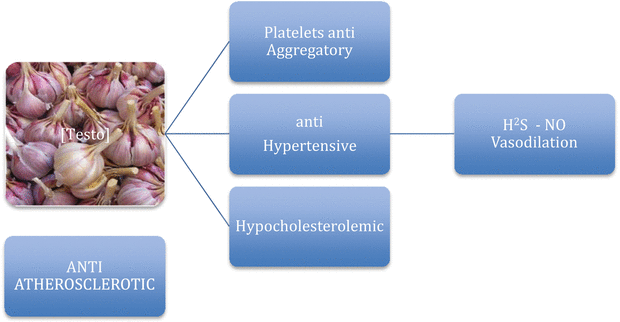

1.5 Arnica montana
Arnica is a perennial herb native to the mountainous regions of Europe and southern Russia and belong to the Asteraceae family. Arnica flowers contain helenanolide-type sesquiterpene lactones, flavonoids (isoquercetin, astragalin, etc.), volatile oils, and coumarins. Goethe recommended it for coronary heart disease and acute treatment of angina pectoris. Although Arnica can improve coronary circulation in much the same manner as Crataegus, it has a more rapid onset of action. Therefore, Arnica is preferred for acute and Crataegus for long-term treatment of coronary heart disease [7–9, 13, 14] (Fig. 1.2).
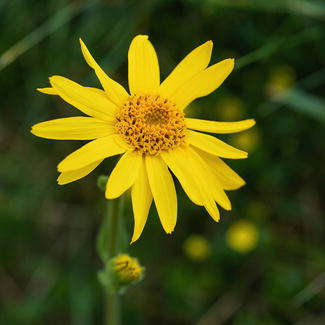


Fig. 1.2
Arnica montana

1.6 Astragalus membranaceus
Astragalus is a small shrub native to temperate regions of the northern hemisphere and belongs to the Fabaceae family. Use of Astragalus roots is very old and well known in traditional Chinese medicine, employed principally as a tonic and for the treatment of diabetes and kidney diseases. Astragalus root contains a series of cycloartane triterpene glycosides named astragalosides I to VII. Several saponins based on the oleanane skeleton have also been reported. Astragalus saponins demonstrated a positive inotropic action, improving walking distance and quality of life in patients with chronic heart failure. Oral administration of extracts of the root countered the rise in blood pressure and plasma renin activity in a hypertensive model. Astragaloside IV improved homocysteine-induced endothelial dysfunction in rat aortic rings via antioxidant activity and exhibited vasodilatory effects. Oral administration of Astragalus has an inhibitory effect on left ventricular hypertrophy induced by pressure overload in rats. After acute myocardial infarction, there is an anti-free radical effect and amelioration of left ventricular function. Astragalus increases the survival rate and improves some abnormal electrophysiological parameters in acute viral myocarditis. Routine therapy combined with oral administration of Astragalus in these patients significantly enhanced immune parameters compared with patients receiving routine therapy alone. Heart mitochondria are also protected by toxic insult experimentally produced with daunorubicin [13, 15–18] (Fig. 1.3).
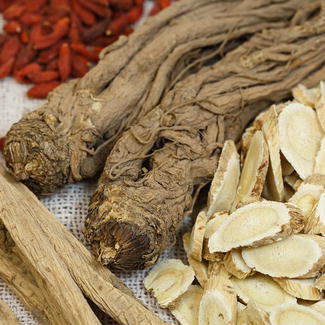
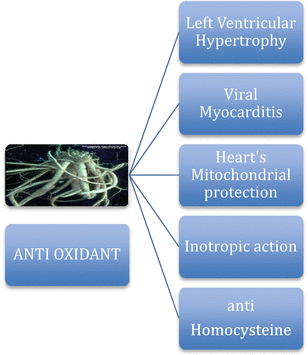

Fig. 1.3
Astragalus membranaceus

1.7 Berberine
Berberine is a quaternary ammonium salt derived from protoberberine, and belongs to the isoquinoline alkaloid family. This molecule is found in the roots, rhizomes, stems, and bark of plants such as Berberis aquifolium and vulgaris, Hydrastis canadensis, Xanthorhiza simplicissima, Tinospora cordifolia, and Eschscholzia californica. A detailed review concluded that berberine possesses a range of cardiovascular properties, including positive inotropic, negative chronotropic, anti-arrhythmic, and vasodilatory activities. In experiments, berberine prevented the development of pressure overload induced by left ventricular hypertrophy in vivo after aortic banding. Oral administration of 10 mg/kg decreased left ventricular, diastolic pressure, and plasma levels of adrenaline and noradrenaline. In a rat model of hypertension, 5–10 mg/kg of berberine improved cardiac contractility and inhibited left ventricular remodeling and global myocardial fibrosis. Such effects might be partially associated with increased nitric oxide and cAMP in left ventricular tissue. Berberine inhibits platelet aggregation and adhesiveness and levels of thromboxane B2, and these could be the important factors behind the anti-ischemic activity of berberine.


Recent research focused on the cholesterol-lowering activity of berberine mediated by the upregulation of hepatic LDL receptor expression and inhibition of cholesterol and triglyceride synthesis. Oral administration of berberine to hyperlipidemic hamsters for 10 days resulted in 26 and 42% decreases in total cholesterol and LDL cholesterol respectively. Human studies seem to demonstrate that berberine might benefit the integrity and function of vascular endothelial cells by improving protective mechanisms: increasing the production of NO and enhancing resistance to hyperglycemia-induced injury [7, 8, 19].
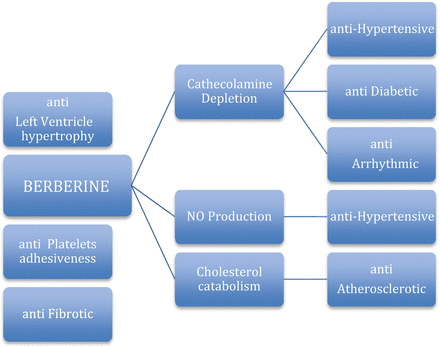

1.8 Camelia sinensis (Green Tea)
Green tea is produced from leaves of Camellia sinensis, an evergreen shrub native to Eastern Asia from Teaceae family. Green tea is the dried leaf component, whereas black tea is produced by a complex wilting and fermentation process. Tea leaves contain varying amounts of polyphenols (most of which are catechins) in addition to smaller quantities of caffeine, theanine, theobromine, theophylline, and phenolic acids. Evidence from clinical trials suggests that green tea might play a role in metabolic syndrome because it may have an impact on body weight, glucose homeostasis, and other cardiovascular risk factors. Green tea helps to reduce the oxidation of low-density lipoproteins, improving cholesterol profiles, reducing platelet aggregation, and finally antagonizing atherosclerosis [7, 8, 19–22] (Fig. 1.4).
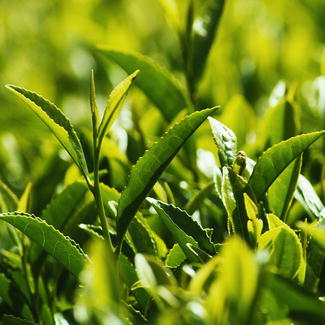
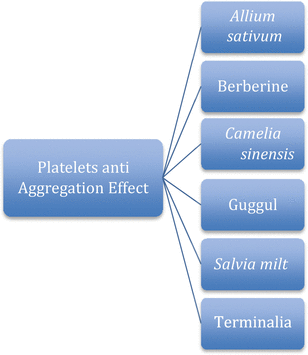

Fig. 1.4
Camelia sinensis

1.9 Commiphora mukul (Guggul)
Guggul is a small shrub that is widely distributed in India and adjacent dry regions from the Burseraceae family. The gum has been used in Indian medicine for centuries as a cardiac tonic, and as a weight-reducing and anti-inflammatory agent.
The dry gum resin obtained from the bark of the tree downregulates the expression of all inflammatory mediators. Research shows that the resin of the guggul tree contains ketonic steroid compounds called guggulsterones and these have the ability to reduce the cholesterol-containing plaque. Guggul also helps to increase the metabolic rate of the body and thus is useful for weight loss.
Guggul, in animal experiments, was as effective as phenylbutazone and ibuprofen in acute and chronic inflammation. A study in 200 patients with ischemic heart disease demonstrated an improvement on electrocardiography and a decrease in episodes of dyspnea and chest pain. Guggul increases fibrinolytic activity and decreases platelet adhesiveness, but the most interesting activity is the improvement of hypothyroid conditions and an increase in triiodothyronine levels. In most studies, the use of guggul leads to a reduction in total cholesterol and HDL. Globally, guggul is considered an important natural remedy for preventing coronary heart disease [23, 24].
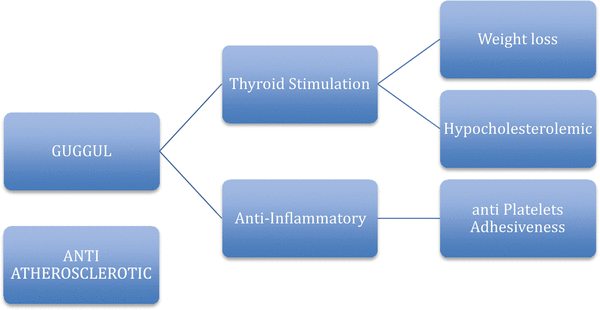

1.10 Convallaria majalis (Lily of the Valley)
Lily of the valley is an herbaceous perennial plant native to the forests of Northern Hemisphere of the Asparagaceae family (previously classified in the Liliaceae family). The aerial parts contain cardenolides and glycosides whose potency is not comparable to that of Digitalis and is also weaker than that of Scilla. Hence Convallaria is mainly used in patients with mild heart failure. The main advantage of Convallaria is its rapid onset of effects and the only remote risk of accumulation of glycosides. Furthermore, the glycosides in Convallaria do not affect the nerve impulse conduction system of the heart; thus, there is no risk of arrhythmias. This plant is therefore very well suited for the treatment of heart failure associated with bradycardia. Crataegus complements Convallaria in the case of an “aging heart.” We can classify lily of the valley as a cardiosedative remedy, well suited to the treatment of functional heart disorders [25].

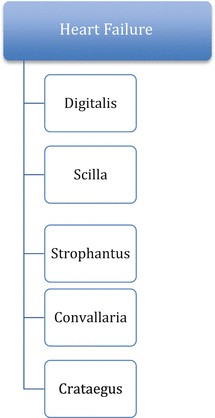


1.11 Crataegus oxyacantha (Hawthorn)
Hawthorn is a spiny tree native to temperate regions in the Northern Hemisphere belonging to Rosaceae family. The use of this herb for the treatment of heart problems dates back to 1800, but the ancients probably knew already the virtues of this plant that they not casually named Crataegus: in the Greek language krátos means strength and this suggests that this plant might give the body energy through the enhancement of heart activity. Today, hawthorn is an official drug in the pharmacopoeias of Brazil, China, Czechoslovakia, France, Germany, Hungary, Russia, and Switzerland. As a measure of its incredible popularity, it is an ingredient in 213 commercial European herbal formulas, mostly for cardiovascular system.
For many years, it has been suggested that hawthorn could be used as an alternative therapy for various cardiovascular diseases, such as angina, hypertension, hyperlipidemia, arrhythmia, and initial congestive heart failure. Besides the antioxidant, positive inotropic, anti-inflammatory, and anticardiac remodeling effects and other cardiovascular protective effects of the hawthorn, active ingredients have been demonstrated in various in vivo and in vitro experiments.
The clinical efficacy of hawthorn can therefore no longer be disputed, but this plant still has not found its rightful place in modern cardiology. Therapy shows effects after 7–8 weeks, but the pharmacologically measurable effects on the myocardium and coronary flow volume persist for several weeks, even after the administration of Crataegus has been discontinued.
The constituents of hawthorn are:
- 1.
Active dehydrocatechins of the flavan type, also classified as oligomeric procyanidins, responsible for the effects on coronary circulation
- 2.
Monomeric flavonoids (hyperoside, quercetin, vitexin rhamnoside), which are important for myocardial metabolism
- 3.
Biogenic amines
- 4.
Triterpene acids
- 5.
Sterols
- 6.
Purines
- 7.
Catechin tannins
In any case, the research confirms that the overall effect of the extract as a whole is more significant than that of its individual constituents.
Many experimental studies in animals have confirmed that Crataegus increases coronary blood flow, inhibiting cAMP. Several studies also documented stimulation of myocardial contractility, through a different mechanism to that of Digitalis, indirectly improving myocardial energy metabolism through mitochondrial activation. This also explains why hawthorn requires a much longer period than Digitalis to take effect and why myocardial reactivity must exist so that the herbal drug can take effect.


It has been verified pharmacologically that Crataegus regulates heart rhythm and standard extracts of the plant demonstrated positive chronotropic and dromotropic effects in addition to negative bathmotropic effects. Crataegus increases myocardial tolerance to oxygen deficiency. An increase in cardiac volume, a reduction of peripheral vascular resistance, and an increase in cardiac performance have also been documented in various studies on animals.
Summarizing Crataegus:
- 1.
Increases coronary and myocardial circulation
- 2.
Improves myocardial contractility, mostly stimulating and protecting mitochondria from lipid peroxidative damage, preventing left ventricular hypertrophy and most functional and structural problems of the heart.
- 3.
Exerts an eurythmic effect on certain types of electrical heart instabilities. Crataegus extract prolongs action potential duration and delays recovery. The effect is similar to the action of class III antiarrhythmic drugs, with a significant decrease in the total number of ventricular ectopic beats, mainly by reducing the number of beats, i.e., ventricular tachycardia.
- 4.
Increases myocardial tolerance to oxygen deficiency
- 5.
Has positive inotropic activity: the force of contraction of the left ventricle is clearly enhanced.
- 6.
Has an anti-inflammatory effect, downregulating COX-2, TNF-α, IL-1β, and IL-6 expression, in addition to reducing nitrative stress and oxidative stress, and thus decreasing apoptosis of myocardial cells.
- 7.
Has an anti-platelet aggregation effect at low doses, as indicated by the increase in bleeding time, decrease in platelet aggregation, and reduction in serum levels of thromboxane.
- 8.
Is effective in lowering blood lipid levels and significantly reducing the ratio between low-density and high lipoprotein. It also increases bile acid excretion and depresses hepatic cholesterol by upregulating hepatic LDL receptors with a consequently greater influx of plasma cholesterol into the liver.
- 9.
Significantly restores the activity of antioxidant enzymes such as superoxide dismutase, catalase, glutathione peroxidase, and glutathione.
- 10.
Antagonizes left ventricular hypertrophy related to hypertension
- 11.
Has a vasodilatory action on both coronary and peripheral circulation that may be mediated by the inhibition of angiotensin-converting enzyme (ACE).

Stay updated, free articles. Join our Telegram channel

Full access? Get Clinical Tree


